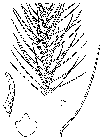Conservation Status

Dacrydium balansae
Brongniart et Grisebach 1869
Common names
Taxonomic notes
Holotype : Balansa 1380 (P). The most closely related species is Dacrydium nidulum De Laubenfels (1969) from New Guinea and Fiji (de Laubenfels 1972).
Description
Tree 4-12(20) m tall. Branches in many small divergent shoots. Bark showing hard and smooth cuticles with various small lenticels, becoming gray with age, fibrous inside, shedding in thick brown plates. Juvenile leaves fine and needle-like, up to 13 mm long, gradually changing into adult leaves. Adult leaves thick, tapering off strongly from a large decurrent base 1-2 mm, divergent and slightly incurved ending in a blunt apex, 3-4.5 mm long, having a strong dorsal carina, sharp margins, often slightly glaucous. Pollen cone cylindrical, 8-15 × 2 mm, terminal, often on short branches, or lateral, or both. Microsporophylls triangular, sharp and not very long. Seed cone terminal, on long or short branches with foliage just below the cone that is 20 mm long; often twisted below the fertile part. Cone scales 3.5-4 mm long, never exceeding more than 1 mm in width. Ovule reversed at first completely buried in the scales of the cone but becoming gradually almost erect. Seed 5 × 3.5mm, separating when ripe from the ridge of the cone scale but remaining more or less surrounded by them, slightly emerging, oval-long, large and thick, tapering off to a dull apex with a lateral, distinct carina (de Laubenfels 1972). See García Esteban et al. (2004) for a detailed characterization of the wood anatomy.
Distribution and Ecology
New Caledonia, at elevations from 0-1000 m (mean 387 m). Within its range, mean annual temperature is 21.1°C, with an average minimum in the coldest month of 14.1°C, and a mean annual precipitation of 1636 mm (Biffin et al. 2011, Table S5).
This map shows herbarium records of Dacrydium species native to New Caledonia. Blue is D. araucarioides, green is D. balansae, orange is D. guillauminii, and red is D lycopodioides. Click on an icon for further information. Distribution data from GBIF (2020.03.30), edited to remove duplicates.
Dacrydium balansae occurs throughout the main island in the drier parts of the forests. It normally grows on serpentine soils from sea level to 1000 m above sea level. The few herbarium specimens that have been collected in ombrophilous forest came from very tall trees almost 20m tall (de Laubenfels 1972).
The IUCN reports that the population status is stable.
Remarkable Specimens
No data as of 2023.02.21.
Ethnobotany
No data as of 2023.02.21.
Observations
De Laubenfels (1972) reports collections from the following locales:
- Blue river (160-200 m elev.) (many collections)
- Bogota peninsula
- Couvelée river
- Dothio Kieho valley (100 m elev.)
- Kalauéhola valley
- Kuana river, east of table Unio
- Me Maoya below Houailou (800-900 m elev.)
- Mois de Mai forests
- Mt. Boulinda below Oua Nepoua (800 m elev.)
- Mont Douetampo (Thio) (800 m elev.)
- Mt. Dzumac footpath (many collcetions)
- Mt. Homedeboa (500-700 m elev.)
- Mt. Koniambo-Koné (400-600 m elev.)
- Mt. Paéoua (600-900 m elev.)
- Mt. Vulcain (many collections)
- Nakety pass (Thio) (150 m elev.)
- Ni (850 m elev.)
- Oué Péoué, slope west of Paéoua (900 m elev.)
- crest of Ouenghi, valley of Tontou (800-1000 m elev.)
- Ouroué (the mouth of Dothio)
- below Téné near Bourail
- Thio, lower valley (10-100 m elev.)
Remarks
The species is named for its collector, Benedict Balansa (1825-1892), French botanist and explorer, as is another gymnosperm, Cycas balansae.
Citations
Thanks to Ferenc Kiss for translating de Laubenfels from the French (2003.11).
See also
Association Endemia, a site devoted to New Caledonian species. Has excellent photos, a range map, and other information. In French.
Brongniart and Grisebach. 1869. Bull. Soc. Bot. France 16 : 328; also Ann. Sci. Nat. Paris, ser. 5, 13 : 344 (1871).
Guillaumin, Bull. Mus. Hist. Nat. Paris 18 : (1912).
Dallimore et al. (1967).
Däniker, Mitt. Bot. Mus. Zürich 142: 45 (1932).
Pilger, in Engler, Pflanzenreich 4(5): (1903).
Sarlin, Bois et Forêts Nouvelle-Calédonie: p. 91 and pl. 20 (1954).





